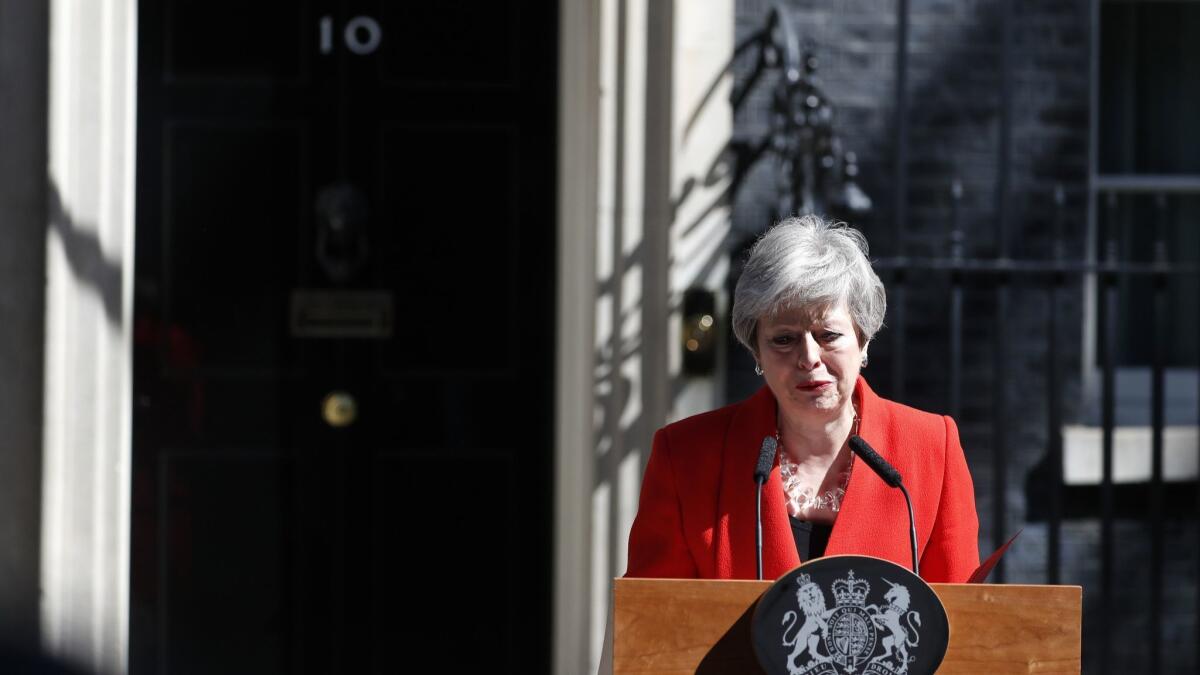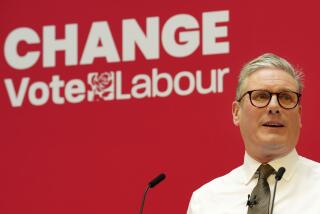Undone by Brexit, British Prime Minister Theresa May steps down as Conservative leader

- Share via
Reporting from LONDON — British Prime Minister Theresa May’s time as Conservative Party leader ended Friday, not with a bang but a whimper.
May, who announced her departure two weeks ago after her career was undone by the Brexit mess, formally stepped down in a private exchange of letters with the party, leaving almost a dozen Conservative contenders fighting to replace her and resume the stalled quest to lead Britain out of the European Union.
The second female prime minister in British history spent the day quietly in her home constituency west of London, rather than the prime minister’s residence at 10 Downing St.
May will remain as acting leader and prime minister for a few weeks while the party picks a successor, who will become the next prime minister.
Conservative lawmakers will hold a secret ballot on Thursday, with any candidates who don’t get at least 5% dropping out. Further rounds will be held the following week until the field is narrowed to two.
The final two candidates will meet in a runoff that will be decided in a mail-in vote by the country’s approximately 160,000 Conservative Party members. The winner will be announced the week of July 22.
So far, 11 Conservative lawmakers are running to replace May, vowing to succeed where she failed and renegotiate Britain’s deal to pull out of the EU.
There’s just one problem: The EU says that’s not going to happen.
“There will be no renegotiation,” European Commission President Jean-Claude Juncker said — not for the first time — last week.
On Friday, Juncker lamented: “Everyone understands English, but nobody understands England.”
May, 62, has seen her three years atop party and country defined, and ultimately destroyed, by Brexit.
The Oxford-educated daughter of a rural vicar, she was picked as party leader in July 2016, weeks after Britain voted 52% to 48% to leave the EU and her predecessor, David Cameron, resigned.
After many months of negotiations, the 27 other EU nations finally agreed late last year to a detailed withdrawal plan with May’s government.
But in one humiliation after another for May, the plan has been rejected three times by Parliament, doomed by both lawmakers who wanted more of a clean break and those who wanted a softer Brexit that kept close economic ties to the bloc.
With British politicians deadlocked, departure day was postponed from March 29 to Oct. 31, and many of May’s Conservative colleagues decided she and her plan had to go.
The impasse has transformed the U.K.’s political map. May’s Conservatives and the main opposition Labor Party are both fractured over how to leave the EU.
Frustrated and angry voters are turning away from the big parties to the upstart Brexit Party led by Nigel Farage and — on the other side of the European divide — the Liberal Democrats and Greens, who want Britain to remain in the EU.
Farage’s Brexit Party came close to winning its first seat in Parliament on Friday, narrowly losing to Labor in a special election in the city of Peterborough. Labor’s share of the vote fell sharply from the last election in 2017, and the Conservatives came in third.
Despite the loss, Farage said the result showed that British politics has “fundamentally changed,” with the stranglehold of Conservative and Labor now broken.
The bookmakers’ favorite to replace May as prime minister, tousle-haired Brexit champion Boris Johnson, has warned that the Conservatives face “extinction” if Britain doesn’t leave the EU on Oct. 31.
Johnson is one of several contenders — including Environment Secretary Michael Gove, Foreign Secretary Jeremy Hunt and Health Secretary Matt Hancock — promising to go back to Brussels and make changes to the Brexit deal.
More to Read
Sign up for Essential California
The most important California stories and recommendations in your inbox every morning.
You may occasionally receive promotional content from the Los Angeles Times.









